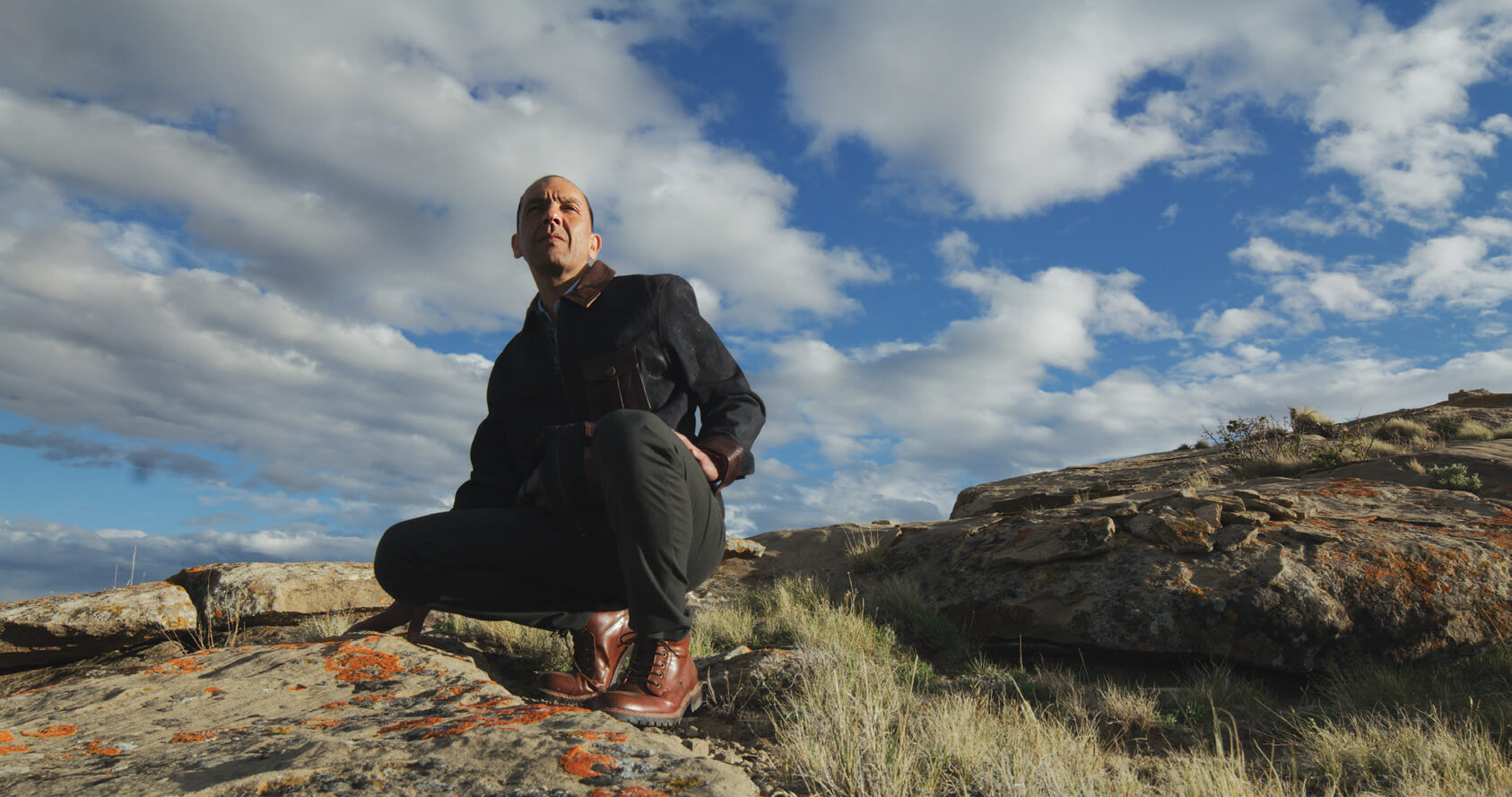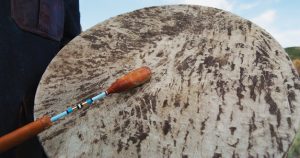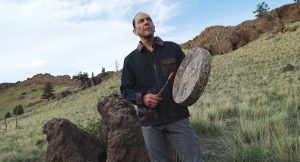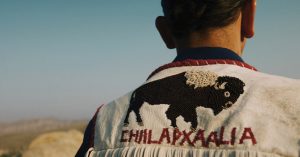
01 Jun Above the Sky
As David Rohm prepared the camera to capture film footage for Golden Eagles: Witnesses to a Changing West, I gazed across the green-speckled red earth and into the wild blue yonder, contemplating the unique spiritual relationship that my tribe and other Plains Indian communities have with golden eagles. I am an enrolled member of the Apsáalooke Nation and grew up along the grassy Little Bighorn River, where golden eagles are prominent and considered sacred intermediaries between earth and sky, between flesh and spirit. Like smoke from the sacred pipe, golden eagles share our prayers, love, and dreams with the First Maker.

Photographed by WILD EXCELLENCE FILMS/DAVID ROHM
This arid basin has been part of the Apsáalooke homeland since time immemorial and was a shared terrain with the Eastern Shoshone during the era of bison and dogs. All of the Plains Tribes knew of this dry landscape, but few utilized it as a place to hunt, gather, trade, or pass through. It is a stark place unto itself, where only the most capable and cunning creatures, like golden eagles, can thrive.
Driving south from the Yellowstone Valley in northwestern Wyoming, the miles and miles of sagebrush-filled countryside give the sense that not much lives or changes here. Indigo skies frame a stunning wall of white-capped mountains to the west, and two-lane roads into Old West-style towns punctuate the feeling of an enigmatic trip back in time. Centuries ago, precious renewable resources — rivers, grasses, and lodgepole pines — led most tribal communities into what we now call Montana, leaving the golden eagles to dominate.
Golden eagles are interwoven into my Apsáalooke culture in countless ways, but most profoundly within our ceremonial heritage. Like all Northern Plains Tribal Nations, we highly value and respect a ceremonial way of life and view individual spiritual development as the deepest form of personal growth. Thousands of years of living alongside golden eagles have shown Native communities in the Northern Plains that eagles have much to teach us about living a life of grace, power, and poise. The world-renowned Sun Dance Ceremony, which is endemic to the Northern Plains and still practiced by every tribal nation in Wyoming and Montana, is as much a Golden Eagle Dance as it is a Sun Dance. Contemporary Sun Dances still maintain their ancient protocols, and golden eagle wings, feathers, bones, and sometimes talons are utilized by the participants during the four-day summertime ceremony. Fasting without food and water, the participants dance gently forward and backward from a center pole in the middle of a wooden arbor. All the while, men Sun Dancers blow a whistle made from a golden eagle wing bone — toot-toot, toot-toot, toot-toot, toot-toot — praying for themselves and all things in creation.
The eagle bone whistles used by Sun Dancers are sacred instruments kept throughout a dancer’s lifetime and used for ceremonial purposes during the year. Men Sun Dancers have the authority to use their whistles at public dances, where they are dressed in their traditional regalia and joined by hundreds of other Plains Indian-style dancers. Traditional dancers carry eagle feather fans and wear hand-sewn attire adorned with colorful beadwork and golden eagle feathers. When a song or moment moves them to blow their whistle and dance, the drum group whom they are saluting must sing a song of ceremonial celebration until the dancer has stopped blowing his whistle. As a singer and spectator at many powwows, I have witnessed and been a part of this special event when a Sun Dancer blows their eagle whistle, and it is always a healing moment for all involved.
The hundreds of powwows held annually across the U.S. and Canada are largely secular events, but the inclusion of golden eagle whistles, feathers, and other dance accouterments establishes a strong air of respect and ceremony. If an eagle feather happens to fall off a dancer’s outfit and land on the floor, rather than grabbing it quickly and putting it aside, it is left to lay there until the song ends, and then a short ceremony is held to pick it up. This is the Feather Pick-Up Ceremony, and it’s always done by an elder military veteran to show respect for their sacrifice and leadership experience.

Doyle drums a sacred song of the Crow people in Wapiti, Wyoming. Photographed by WILD EXCELLENCE FILMS/DAVID ROHM
Golden eagle tail feathers are still used today for ceremonial purposes and for badges of accomplishment. Native American high school and college graduates are often gifted a tail feather to bead and sew onto their graduation cap. This is a beautiful example of how ancient values continue to be honored and included in the modern world. In Indian Country, new ways of life become traditional by maintaining a thread of continuity and a vision of authenticity. Going back hundreds of years, golden eagle tail feathers were awarded to warriors who “counted coups,” or were valiant and successful in battle. These feathers could be saved until there were enough to make a warrior’s bonnet. My tribe’s tradition is that a full golden eagle tail feather headdress requires 36 tail feathers — 12 feathers from three golden eagles — no small feat.
In the Bighorn Basin, watching these powerful birds bring an array of deadly prey to their fledglings, I was reminded of the courage, skill, and determination of those in my tribe who took those feathers from a live golden eagle. The Apsáalooke oral tradition of how we first acquired the tipi comes from the misadventure of a young man named Yellow Leggings on a mission to capture golden eagle tail feathers. Different versions of the story describe how Yellow Leggings built an eagle trap and was waiting for one to land on his bait so he could reach up and grab the three prized tail feathers. Before this could happen, fate intervened, and the young eagle catcher’s trap was crushed by a falling tree, sparing his life and leading to the discovery of the tipi.
Medicine Lodge State Park in Wyoming contains a wondrous archive of red ochre pictographs that vividly display the many thousands of years that Native people have lived in this quiet, peaceful basin. Since time immemorial, tribes like the Shoshone, Blackfeet, Salish, and Kootenai — and, later, my tribe, the Apsáalooke — came to know this place as home. The pictographs reflect the deep history of oral traditions that honor and connect with eagles and other majestic creatures, so they are healing medicine to the eyes.

Doyle’s intricately beaded and embroidered clothing includes his tribal name spelled out in the Apsáalooke (Crow) Nation language: Old Buffalo Bull. Photographed by WILD EXCELLENCE FILMS/DAVID ROHM
In the Apsáalooke community, there are many stories about the origins of the human friendship with golden eagles. The Medicine Lodge reminds me of how eagles contributed powerful spiritual medicine to the first Apsáalooke Lodge. Elders in my tribe share the story of how golden eagles gave us the sacred door pins, made from chokecherry wood, to lace together above the door and secure the lodge from unraveling. When the fierce winds of March and April blow eagle fledglings from their nests, the parents sit behind their chicks and cover them tightly with their wings, shielding them from the elements. The golden eagle gave the Apsáalooke the authority to use this medicine on their lodges, and it continues to keep family units safe and protected during the Crow Fair in August, when the tiny town of Crow Agency, Montana becomes the Tipi Capital of the World.
Northern Plains Indigenous cultures value golden eagles as much or more than any group of people in the world, and this is evident in all aspects of how we self-identify with them. Bison provided tribes here with food, clothing, shelter, and a spiritual foundation, and golden eagles gave tribal communities an example of indomitable elegance and metaphysical transcendence. Founded on the belief that each person must seek their own dream in this life, Plains worldview looks to the eagle to lead us beyond our perceived limits and toward a visionary approach to each day. They inspire us to stretch ourselves beyond where our eyes can see, and that may be their greatest gift.




No Comments